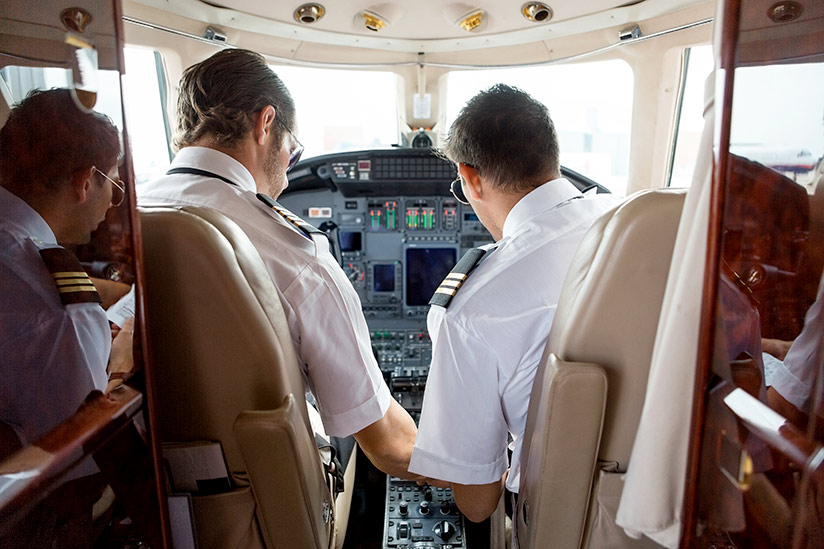
An analysis of psychological assessment data from more than 350 business aviation professionals1 reveals a significant facet of the typical “pilot personality,” overlooked or misconstrued in earlier studies, that can explain the so-called boomerang effect — an unanticipated response to crew resource management (CRM) training in which the attitudes of some participants remain unchanged or even move in the direction opposite the one intended.
The analysis examined responses from pilots, maintenance technicians, managers, cabin crew and schedulers who operate, maintain and manage corporate aircraft and other transportation; it was conducted using the Birkman Method, a psychological assessment tool designed to measure personality characteristics that influence behaviors, motivations and perceptions.
More than 25 percent of the Birkman sample (far in excess of the general population and far more so than on any other facet) is “reversed” on “Assertiveness,” meaning that when given instructions by someone who is not a member of the community or who they feel lacks command authority over the group and its activities, they may unexpectedly abandon their usual cooperative demeanor and instead become outspokenly oppositional, Social psychologists call this reaction a boomerang effect.2
Not only does their reactive behavior destroy the atmosphere of comity and cooperation that aviation professionals need to be at their best, but it also can doom change initiatives of any kind from the outset. The resulting resentment and resistance can easily broaden to include consultants and even corporate human resources (HR) partners, especially when interventions occur as a response to intradepartmental conflict, a safety lapse, executive dissatisfaction, or a combination of all three. Because stress levels are already so high, intrusion from outside the department often causes the department’s members to circle the wagons, leading to a kind of false unity that usually makes the original problem worse.
Department Profile
The Birkman data also can be used to construct a profile of the entire aviation department — not just pilots, but the other groups within the department and their profiles in relation to the roles they play in the organization. In this way, the data offer the potential for new insights into:
- The psychological and cultural profile of business aviation departments as a whole;
- The profile’s likely impact on operational safety, efficiency and productivity; and,
- The steps that departments and their managers might take to build and maintain a high-performance work team, aligned with the corporation’s strategic goals and organizational culture.
In seeking such insights, however, several less recent findings are relevant.
First, research on psychological assessment instruments has consistently shown that any psychological profile, individual or organizational, is highly resistant if not altogether inimical to change. In part, this is traceable to the conviction that established behaviors are the source of success and will continue to be valuable even in the face of clear evidence to the contrary.
But even when the work environment changes in ways that fail to match individual needs and so creates highly stressful situations, the fundamental traits of a profile do not change.3 Coaching may help those involved learn new skills and anticipate and manage stress more effectively, but even then, the change in individual and group scores remains limited.
Second, the consistency of the profile (or set of profiles) that describes business aviation suggests that the profession constitutes what sociologists call an “occupational community” or “professional subculture” — a fairly strong and distinctive cultural unit, embedded within a larger organization. As with other corporate subcultures — sales and engineering, for example, or information technology, HR and other support groups — a strong and well-established occupational community may never fully accept the values, management systems and strategic goals of the parent organization.
In fact, according to a 1982 study, any attempt to bring the highly diverse constituent parts of large, multifunctional organizations under the wing of a single corporate culture can and often does lead to a kind of internecine cultural warfare between individual occupational communities and the management hierarchy.4
“Occupational communities promote self-serving interpretations of the nature and relevance of their work in the organization as a means of generating control over that work,” the study said. “To the extent [they] succeed in convincing themselves and others that they solely command the expertise necessary to execute and evaluate their work, they gain autonomy and discretion.”
With business aviation, the forces of separation are even greater than with other occupational communities, since its members are almost always housed off campus, at a physical distance from the rest of the company; spend most their time alone or with each other, often in the course of trips off site; and are focused more on the needs and activities of a small group of executives than on the concerns and values of the corporation at large.
Given the inflexibility of psychological profiles and the strength of business aviation’s identity as an occupational subculture, the range of a department’s ability to craft its available assets into a diversified and strategically aligned team is likely to be severely limited. “When you try to turn ducks into swans by stretching their necks,” one frustrated aviation manager observed, “you don’t get swans. You get ducks with sore necks.”
In many respects, the business aviation profile is well-adapted to the profession’s responsibilities. Its strong emphasis on rules, regulations and adherence to step-by-step procedures, for example, are essential to safe, effective operation of business aircraft and successful, well-planned trips. While it would be helpful in many ways to have some members with a broader, more strategic perspective of the role of aviation, not everyone in the department needs to see things that way.
Making Changes
But in many respects the profile is not good news for the aviation manager or corporate executive who hopes to make significant changes in a business aviation department, whether in pursuit of improved alignment with corporate strategy, increased operational efficiency, or simply a personal challenge.
In most cases, the inflexibility and inherent liabilities of the business aviation profile, coupled with its members’ strong sense of professional identity, conspire against any but the most limited developmental initiatives. It will always be worthwhile to pursue CRM training, International Standard for Business Operations (ISBAO) certification, and other predominantly technical and safety-driven programs. But to do so without fully acknowledging and addressing the longer-term, more deeply seated cultural forces at work against change of any kind, especially change initiated from outside the department, places potentially crippling limitations on the effectiveness of these and other such interventions.
To be truly effective, team building, safety culture and culture change (which play, at best, a secondary or adjunct role in much existing safety practice and research) must be seen instead as indispensable components of lasting, resilient, and widespread change.
Following the Steps
Several steps are necessary to create or reinvent an aviation department and its culture:
- Using a reliable assessment instrument to create a psychological profile of the department;
- In consultation with corporate management, establishing strategically aligned metrics for the aviation group that can be used to quantify and track the value that the group creates for the corporation and contributes to the achievement of key corporate objectives; and,
- Setting aside and defending significant, mandatory and regularly scheduled times for group discussion and interaction, both among members of the group and with corporate and industry personnel outside the aviation
All of the steps, but especially the first, are critical. Not all departments are the same, and a discussion of the ways a specific department is the same as or different from others can help identify its unique strengths and challenges. It can also provide valuable input to recruiting, hiring and management development decisions, including corporate interface assignments. But most important, it can challenge unexamined assumptions about the shared behaviors and values that define aviation as an occupational community and often blind its members to differences in individual interests, needs and perspectives.5
No one who has worked with business aviation departments or tried to promote team building or change initiatives inside or outside aviation will believe that any of the steps are quick or easy to implement. In most cases, they take place only when disruptions in operations have made them necessary and even more difficult to implement. Even under the best of circumstances, they call for skills that may not be present in most aviation departments. But it’s important to see them with clear eyes.
On the positive side, they can expand the existing boundaries of the department in ways that make it less insular and its members more skillful, resilient and better able to cope with unexpected change. The members’ profiles may not change, but their ability — and the department’s — to anticipate, manage and ultimately avoid stressful and dangerous situations will.
An improved, deeper understanding of each other and other parts of the organization will help the department understand how better to support corporate objectives and, in doing so, increase the level of safety, efficiency and customer service it provides — itself an advantage in defining, expanding and strengthening the group’s power of self-determination. In short, the successful department may, in better understanding and utilizing its resources, change its cultural profile in ways that actually decrease, not increase, its vulnerability to incursions on its identity and effectiveness.
Regardless, the steps recommended here are a demonstrably better approach to managing the department than trusting a more parochial perception of its interests and relationship to the organization. Over time, an insular course of action will not improve its lot. In fact, like any other group that fails to examine and develop its own culture, the business aviation department will in time become increasingly autocratic, more mindlessly focused on its relationship with its most powerful passengers, and more certain that the quality of its work exceeds industry expectations. It’s a course of action that has left more than one aviation department vulnerable to the shock of a sudden change and less valuable in the eyes of the organization.
Jerry Dibble is an organization design consultant who has worked with numerous corporate flight departments.
The views expressed are the author’s and do not necessarily reflect those of Flight Safety Foundation.
Notes
- Dibble, Jerry A. (2022) “What the Birkman Method Can Tell Us About the Psychological Profile of Business Aviation Departments, Their Leadership, Strengths and Challenges.” The International Journal of Aerospace Psychology Volume 32 (Issue 4) 307–317, DOI: 10.1080/24721840.2022.2114905
- The percentage of reversals in the Birkman data is higher than the percentage of boomerang reactions to CRM training that Helmreich et al. report, but in the same range and with the same characteristic effects.
- Ferguson, C. J. “A Meta-Analysis of Normal and Disordered Personality Across the Life Span.” Journal of Personality and Social Psychology Volume 98 (2010): 659–667. Ferguson suggests that changes in scores over time are more the result of measurement error than actual changes in personality, especially after age 30. See also Hofstede, Geert; McCrae, Robert R. “Personality and Culture Revisited: Traits and Dimensions of Culture.” Cross-Cultural Research: The Journal of Comparative Social Science Volume 38 (2004) DOI: 10.1177/1069397103259443. On page 75, McCrae, the co-developer of the NEO Personality Inventory, writes that “longitudinal studies … show that personality traits are highly stable in adulthood and largely impervious to the influence of life experience.”
- Van Maanen, J.; Barley, S. R. “Occupational Communities: Culture and Control in Organizations,” T[echnical] R[eport]-10. Office of Naval Research Organizational Effectiveness Group/Massachusetts Institute of Technology Sloan School of Management. Cambridge, Massachusetts, U.S. 1982.
- This is especially true of differences between the cabin crew and flight crew, which often result in those with the most direct access to key passengers being excluded from or marginalized during group decision-making.
Image: © Tyler Olson | Adobe Stock


